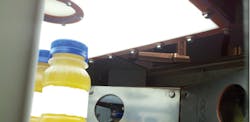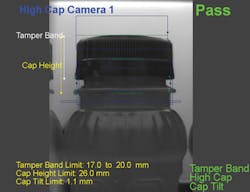Industrial Inspection: Smart cameras check bottles at high-speed
In today's manufacturing environments, products are being produced at increasing rates. This is especially true in the beverage industry where bottles are filled, capped and inspected. Cap inspection, tamper band and printed date code must be performed quickly to keep up with demand. The systems that perform these tasks must be designed so that wash-down and sterilization can be completed rapidly.
This was the task faced by EPIC Systems (St. Louis, MO, USA; www.epicmachinevision.com) when a major producer of soft drinks approached the company to develop a system to inspect 6oz plastic bottles of fruit juice at speeds of up to 900 units per minute.
The bottle inspection system was placed after the company's filler and capper machine. It was engineered to ensure the correct cap position, perform tamper band verification and check whether a printed date code was present on the top of the cap. To perform this task, EPIC Systems' vision system uses three In-Sight 5600 smart cameras from Cognex (Natick, MA, USA; www.cognex.com), each of which captures a 120° segment of the exterior surface of the containers.
Fitted with 16mm focal length Fujinon lenses from Fujifilm (Minato, Tokyo; www.fujifilmusa.com), the cameras are placed approximately 8in from the bottles as they pass along a 4in wide conveyor. Another In-Sight 5600 smart camera views the top of the bottle cap through a DLPW 300 x 300mm flat dome light from Smart Vision Lights (Muskegon, MI, USA; www.smartvisionlights.com). All four cameras were interfaced over Ethernet to a Control Logix PLC from Allen-Bradley (Milwaukee, WI, USA; www.ab.rockwellautomation.com).
To ensure wash down and sterilization can be performed, each of the cameras is mounted in a rugged enclosure from Allison Park Group (APG, Allison Park, PA, USA; www.apgvision.com). Likewise, since the DLPW 300 x 300mm flat dome light is enclosed in a stainless steel housing, it can withstand the harsh environmental conditions demanded by wash-down procedures.
"In the design of the vision system, it was necessary to evenly illuminate the sides and the top of the containers as they move through the bottle inspection station," says Chris Walker, Project Manager with EPIC Systems. "Rather than place LED lighting around the three cameras to illuminate the sides of the containers, simple white back reflectors were placed opposite each camera. This reflected the light from the flat dome illuminator to back-light the bottles. In addition, the light indirectly illuminates the front of the bottles, allowing for an accurate tamper band inspection measurement. Thus, a single light is used to produce a top indirect illumination, indirect front lighting and backlighting from the reflectors to distinguish the bottle's outer-edge features."
The bottles are tracked by an incremental encoder as they move along the conveyor at 900 bottles per minute. The encoder is fitted to the conveyor belt shaft and interfaced to the PLC. An optical switch is also interfaced to the PLC and triggers each camera, to capture an image at a 150μs exposure time.
Walker and his colleagues used Cognex's In-Sight Explorer software to analyze whether the cap and tamper band was correctly placed, and the printed date code was present on the top of the cap.
"To check the placement of the cap and tamper band," says Walker, "it is necessary to accurately locate the position of the bottle in the field of view of the image." To do so, edge detection tools are first used to determine the position of the top and shoulder of the bottle. Once this is determined, regions of interest (ROI) are automatically placed around specific areas in the image where the cap and tamper band are located. Measurements such as the distance from the cap shoulder to the tamper band (or pull-up), cap height measurement and the cap height can then be determined. These measurements are performed on all three images captured from the three In-Sight 5600 smart cameras to provide a 360° inspection of the container.
To check whether printed characters are present on the top of the container, captured images are first thresholded and a morphology operator is used to dilate the black pixels within the image. An edge detector can then be used to place a ROI around the text and the percentage of black pixels within the bounding box counted.
"In this way," says Walker," bottle inspection systems can determine whether the correct amount of ink has been placed on the top of the bottle cap." Should a cap, tamper band or cap inspection fail these inspections, an output from the PLC is used to trigger a pneumatic rejection mechanism from Filtec (Torrance, CA, USA; www.filtec.com), that ejects the container from the conveyor.
To allow the operator to visualize the images as they are captured, the system uses a PanelView graphic terminal from Allen-Bradley that is interfaced to the Control Logix PLC. Running Cognex's Vision View software in conjunction with Allen-Bradley's Factory Talk View software allows the operator to visualize images and control the system from a single HMI.
EPIC Systems has installed more than 100 bottle inspection vision systems of various types and designs at bottling and canning facilities worldwide.



